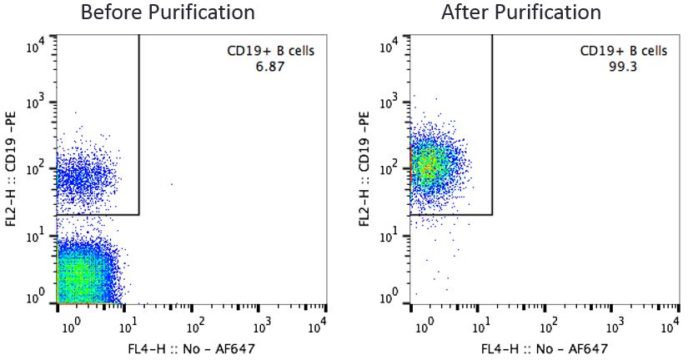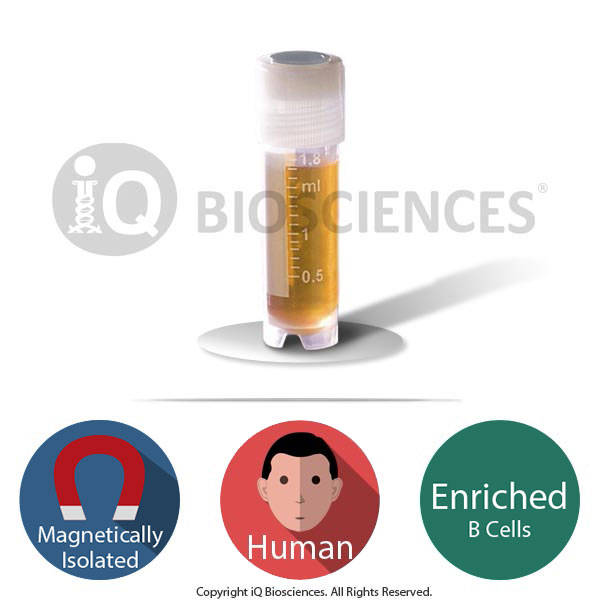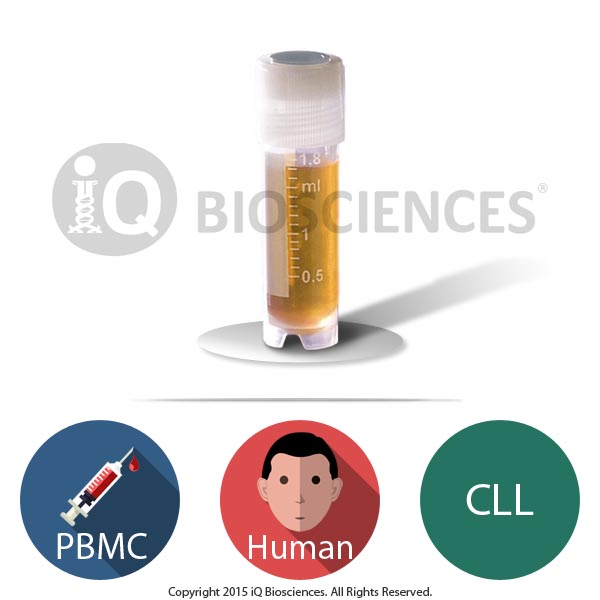- Human B cells purified from PBMCs of healthy blood donors sourced from a world-renowned blood center
- Greater than 90% post-selection purity achieved via magnetic isolation
- Carefully cryopreserved to ensure high viability (> 90%) upon thawing
- All orders come with an iQ Certificate of Analysis
Purified Human B Cells
$510.00 – $680.00
Description
Human B Cells
Different subsets of human B cells are found in the blood with each population classified according to their maturation stage. In a typical adult, approximately 2% of circulating B cells are of the immature type, still undergoing development to become a naïve B cell capable of recognizing antigen. Once B cells finish development, they become naïve B cells, which account for 60-70% of the B cells found in the blood. These cells simultaneously express IgM and IgD and have not undergone somatic hypermutation. Some naïve B cells that have experienced antigen become memory B cells, which comprise 20-30% of total circulating B cells. These cells have undergone somatic hypermutation, display mutations in their Ig variable regions, and may have also undergone Ig class switching. The last subset of circulating B cells, which can be derived from naïve and memory cells, are plasmablasts. This cell population makes up approximately 2% of circulating B cells and function to produce antibodies. Each of these four subsets can be distinguished by their cell surface markers.
B Cell Application Summary
Purified human B cells are a good source of cells to study the biology of B cells and their role in the immune system. B cells are responsible for presenting antigen to T cells, producing certain cytokines, and most importantly, producing antibodies. Thus, B cells can be used for a variety of functional assays, including ELISAs for production of cytokines and antibodies, proliferation assays, and plaque-forming cell assays.
The negative isolation of B cells leaves them untouched without any antibody binding to cell surface markers. This leaves all cell surface proteins eligible to be bound to antibodies or other molecules for functional or population characterization studies.
In contrast, positive isolation of B cells may lead to internalization of the marker that was used to isolate the cells. In most cases, these markers are only used for identification purposes and may not have any effect on function, but it will depend on the organism and function. Therefore, cells isolated using this method may also be employed for functional or population characterization studies with the knowledge that the isolation marker may be internalized and not present.
B Cell Enrichment
Collection of samples
Leukapheresis was performed on verified healthy donors at a world-renowned blood center to obtain PBMCs. PBMCs were carefully washed to remove excess buffers according to iQ Biosciences’ standard operating procedures to obtain clean and healthy PBMCs.
Isolation of Human B cells
To enrich for B cells by the negative isolation method, PBMCs were incubated with antibodies against T cells, NK cells, dendritic cells, monocytes, granulocytes, and erythrocytes in a test tube, which was subsequently subjected to a magnet. Cells labeled with the antibodies bound to the magnet through the test tube wall, while unlabeled cells, the B cells, were decanted into a fresh tube to obtain the enriched population.
For the positive selection method, PBMCs were incubated in a test tube with antibodies against a B cell-specific marker and subsequently subjected to a magnet, similar to negative isolation. However, the cells that were decanted into the fresh test tube were the non-B cells, which can be used for other purposes, while the labeled B cells were left bound to the magnet through the test tube wall. The test tube was then removed from the magnet to release the purified B cells directly into the test tube.
Contact us for more information about purchasing our magnetically isolated B cells.
Purity
A small aliquot of cells was tested for post-sort purity by flow cytometry analysis. Purity of B cells, as defined by CD19 expression, was > 90% (Figure 1).

Figure 1. Purity of B cells after negative magnetic isolation from PBMCs. In this representation, human PBMCs were incubated with antibodies against T cells, NK cells, dendritic cells, monocytes, granulocytes, and erythrocytes and subjected to negative magnetic isolation to obtain untouched B cells. A small aliquot was taken after selection to evaluate post-sort purity (right). Percent of CD19+ cells in PBMCs is also shown (left).
Cryopreservation and storage
Purified B cells were cryopreserved carefully using iQ Biosciences’ cryopreservation protocol that ensures high viability (> 90%) after thawing.
Cells should be stored at < -120°C once they are received, such as within a liquid nitrogen tank (vapor phase).
Additional information
| Available Size(s) | |
|---|---|
| Cell Type | |
| Format | |
| Species | |
| Tissue Type | |
| Viability | > 90% |
We are Committed to Ethical Practices
iQ Biosciences’ human primary cell products are lawfully obtained in accordance with Local, State, and Federal U.S. requirements, and the collection of cells complies with ethical requirements. Our cells are obtained from normal or disease patient volunteers participating in a donor program that is approved by an Institutional Review Board (IRB) or Human Subject Committee. A signed and witnessed consent form is obtained from donor volunteers prior to starting the collection protocol. Strict controls on personal identifiers of volunteers are in place in order to protect their privacy.
For US customers, we ship via FedEx Overnight Shipping. Shipping charges will vary per shipping address (based on ZIP code) and are estimated to be $140.
For international (non-US) customers, we work closely with you and our couriers to ensure all necessary documentation is in place for international shipments to significantly reduce the chance of delays at Customs. For the export of non-human primate samples, this includes preparing CITES permits, as well as any other documentation as required by country. Please submit an inquiry to orders@iqbiosciences.com for your estimated time of delivery and shipping charges.
Austria
Hölzel Diagnostika Handels GmbH
Tel: +49 221 126 02 66
Email: info@hoelzel.de
Web: https://www.hoelzel-biotech.com/
Canada
Cedarlane
Tel: +1 (289) 288-0001
Toll Free (North America): +1 (800) 268-5058
Fax: +1 (289) 288-0020
Email: sales@cedarlanelabs.com
Web: https://www.cedarlanelabs.com
China
BIOHUB INTERNATIONAL TRADE CO., LTD.
上海起发实验试剂有限公司
Address: Chuansha Rd #6619, Pudong, Shanghai, Zipcode: 201200 P.R.China
Tel: 0086-021-50724187
Phone: +86-15921799099
Fax: 0086-021-50724961
Email: sale3@78bio.com
Web: www.qfbio.com
European Union
Caltag Medsystems Ltd.
Email: office@caltagmedsystems.co.uk
Web: https://www.caltagmedsystems.co.uk
tebu-bio
Web: https://www.tebu-bio.com
Or Find a local contact
Germany
Hölzel Diagnostika Handels GmbH
Tel: +49 221 126 02 66
Email: info@hoelzel.de
Web: https://www.hoelzel-biotech.com/
Zageno
Web: https://zageno.com/
Ireland
2B Scientific Ltd
Tel: +44(0) 1869 238033
Fax: +44(0) 1869 238034
Email: sales@2BScientific.com
Web: https://www.2bscientific.com
India
Cell & Gene BioSolutions Pvt. Ltd.
#478 C, SLV Complex, Raghavendra Swamy Mutt Road
Opp. Turahalli Water Tank, Turahalli, Subramanyapura Post
Uttarahalli Hobli, Bengaluru-560061, Karnataka, India
Phone: +91 97317 14670
Phone: +91 98809 25033
Email: info@cgbios.com
Web: www.cgbios.com
Japan
Cosmo Bio Co., Ltd.
Tel: +81 (03) 5632 9610
Fax: +81 (03) 5632 9619
Email: nsmail@cosmobio.co.jp
Web: https://www.cosmobio.co.jp
Qatar
Sedeer Medical Services and Trading LLC
Tel: +974 4434 9191
Email: info@sedeer.com
Web: https://sedeer.com/
Singapore
Omnicell Pte Ltd
Tel: +65 6747 0201
Email: enquiry@omnicell.com.sg
Web: https://omnicell.com.sg/</a
South Korea
BioClone
Tel: +82-2-2690-0058
Email: bioclone@bioclone.co.kr
Web: http://www.bioclone.co.kr
Switzerland
Hölzel Diagnostika Handels GmbH
Tel: +49 221 126 02 66
Email: info@hoelzel.de
Web: https://www.hoelzel-biotech.com/
Taiwan
Hycell International Co. Ltd.
Tel: +886-2-2877-1122
Fax: +886-2-2876-1520
Web: http://www.hycell.com.tw
United Kingdom
2B Scientific Ltd
Tel: +44(0) 1869 238033
Fax: +44(0) 1869 238034
Email: sales@2BScientific.com
Web: https://www.2bscientific.com
Caltag Medsystems Ltd.
Tel: +44 (0)1280 827460
Fax: +44 (0)1280 827466
Email: office@caltagmedsystems.co.uk
Web: https://www.caltagmedsystems.co.uk
tebu-bio
Tel: +44 (0)1733 421880
Fax: +44 (0)1733 421882
Email: uk@tebu-bio.com
Web: https://www.tebu-bio.com
Zageno
Web: https://zageno.com/
United States
Fisher Scientific
Tel: 1-800-766-7000
Web: https://www.fishersci.com
Quartzy
Web: https://www.quartzy.com
VWR International
Tel: 1-800-932-5000
Web: https://www.vwr.com
Zageno
Web: https://zageno.com/





